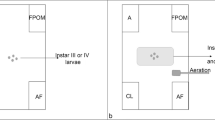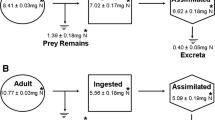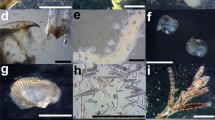Summary
Morphological, physiological and ecological evidence is used to show that terrestrial gastropods and isopods, although both can be considered as “primary consumers”, deal quite differently with the vegetabilic matter they use as food. Gastropods are both efficient digesters and assimilators whereas isopods are efficient digesters but usually inefficient assimilators. This combination may require the isopods to turn to coprophagy as a means of recovering some of the products of digestion that they had been unable to assimilate during the first passage of food through the gut. Furthermore, the faeces of isopods may contain dissolved nutrients and digestive enzymes that could be distributed through various routes of the food web of which these animals are parts.
Similar content being viewed by others
References
Alikhan, M.A.: The internal anatomy of the woodlouse, Metoponorthus pruinosus (Brandt) (Porcellionidae, Peracarida). Can. J. Zool. 46, 321–327 (1968)
Alikhan, M.A.: The fine structure of the midgut epithelium in the woodlouse Porcellio laevis Latreille (Isopoda, Porcellionidae). Crustaceana Suppl. 3, 101–109 (1972)
Bolton, P.J., Phillipson, J.: Burrowing, feeding, egestion and energy budets of Allolobophora rosea (Savigny) (Lumbricidae). Oecologia (Berl.) 23, 225–245 (1976)
Bütschli, O.: Vorlesungen über Vergleichende Anatomie, 4. Lieferung, Ernährungsorgane, 380 pp. Berlin: Springer 1924
Clifford, B., Witkus, E.R.: The fine structure of the hepatopancreas of the woodlouse, Oniscus asellus. J. Morphol. 135, 335–349 (1971)
Crossley, D.A.Jr.: The roles of terrestrial saprophagous arthropods in forest soils: Current status of concepts. In: The role of arthropods in forest ecosystems, pp. 49–56 (W.J. Mattson, ed.). Berlin-Heidelberg-New York: Springer 1977
Dallinger, R.: The flow of copper through a terrestrial food chain. III. Selection of an optimum diet by isopods. Oecologia (Berl.) 30, 273–276 (1977)
Dallinger, R., Wieser, W.: The flow of copper through a terrestrial food chain. I. Copper and nutrition in isopods. Oecologia (Berl.) 30, 253–264 (1977)
Drift, J. van der: The role of the soil fauna in the decomposition of forest litter. In: Proc. 15th Intern. Cong. Zool., pp. 357–360 (1958)
Edwards, C.A., Heath, G.W.: The role of soil animals in breakdown of leaf material. In: Soil organisms, pp. 76–84 (J. Doeksen, J. van der Drift, eds.). Amsterdam: North Holland 1963
Frömming, E.: Quantitative Untersuchungen über die Bedeutung bodenbewohnender Landschnecken für den Abbau des Fallaubes. Biol. Zbl. 75, 705–711 (1956)
Funke, W.: Energieumsatz von Tierpopulationen in Land-Ökosystemen. Verh. Dtsch. Zool. Ges. 65, Jahresversammlung, pp. 95–106 Stuttgart: Fischer 1972
Gere, G.: The examination of the feeding biology and the humificative function of Diplopoda and Isopoda. Acta Biol. Hungar. 6, 257–271 (1956)
Goodrich, A.L.: The origin and fate of the entoderm elements in the embryogeny of Porcellio laevis Latr. and Armadillidium nasatum B.L. (Isopoda). J. Morphol. 64, 401–429 (1939)
Hartenstein, R.: Feeding, digestion glycogen and the environmental conditions of the digestive system in Oniscus asellus. J. Insect Physiol. 10, 611–621 (1964a)
Hassall, M.: Consumption of leaf litter by the terrestrial isopod Philoscia muscorum in relation to food availability in a dune grassland ecosystem. Ecol. Bull. (Stockh.) 25, 550–553 (1977a)
Hassall, M.: The functional morphology of the mouthparts and foregut in the terrestrial isopod Philoscia muscorum (Scopoli 1763). Crustaceana 33, 225–236 (1977b)
Hassall, M., Jennings, J.B.: Adaptive features of gut structure and digestive physiology in the terrestrial isopod Philoscia muscorum (Scopoli 1763). Biol. Bull. 149, 348–364 (1975)
Hassall, M., Sutton, S.L.: The role of isopods as decomposers in a dune grassland ecosystem. Proc. Roy. Dublin Acad. Ser. A, 6, 117–127 (1977)
Herlitzius, R., Herlitzius, H.: Streuabbau in Laubwäldern. Oecologia (Berl.) 30, 147–171 (1977)
Holdich, D.M.: The midgut/hindgut controversy in isopods. Crustaceana 24, 212–214 (1973)
Hubbell, S.P., Sikora, A., Paris, O.H.: Radiotracer, gravimetric and calorimetric studies of ingestion and assimilation rates of an isopod: In: Health physics, Vol. 11, pp. 1485–1501. New York: Pergamon Press 1965
Hyman, L.H.: The invertebrates, Vol. VI. Mollusca I, 792 pp. New York: McGraw-Hill 1967
Jordan, H.: Vergleichende Physiologie Wirbelloser Tiere, 1. Bd. Die Ernährung. Jena: Fischer 1913
Kaplan, D.L., Hartenstein, R.: Studies on monooxygenases and dioxygenases in soil macroinvertebrates and bacterial isolates from the gut of the terrestrial isopod Oniscus asellus L. Comp. Biochem. Physiol. 60B, 47–50 (1978)
Kühnelt, W.: Bodenbiologie. Wien: Herold 1950
Lofty, J.R.: Oligochaetes. In: Biology of plant litter decomposition, Vol. 2, pp. 467–488 (C.H. Dickinson, G.J.F. Pugh, eds.). New York-London: Academic Press 1974
Mason, C.F.: Food, feeding rates and assimilation in woodland snails. Oecologia (Berl.) 4, 358–373 (1970)
McBrayer, J.F., Reichle, D.E.: Throphic structure and feeding rates of forest soil invertebrate populations. Oikos 22, 381–388 (1971)
McMurrich, J.P.: The epithelium of the so-called midgut of the terrestrial isopods. J. Morphol. 14, 83–108 (1897)
Moser, H.: Untersuchungen über den Kupferstoffwechsel bei der Weinbergschnecke (H. pomatia L.). Thesis, University of Innsbruck, Austria (1978)
Murlin, J.R.: Absorption and secretion in the digestive system of the land isopods. Proc. Acad. Nat. Sci. Philadelphia 54, 284–359 (1902)
Nusbaum-Hilarowicz, J.: Studien über die Physiologie der Verdauung bei den Landasseln (Isopoda). Biol. Zbl. 37, 49–55 (1917)
Pacaut, M., Vigier, P.: Les glandes salivaires de l'escargot Helix pomatia. Contribution à l'histophysiologie glandulaire. Arch. Anat. Microsc. 8 (1906)
Phillipson, J.: Ecological energetics. London: Arnold 1966
Phillipson, J., Abel, R., Steel, S., Woodell, S.R.J.: Earthworm numbers, biomass and respiratory metabolism in a beech woodland — Wytham Woods, Oxford. Oecologia (Berl.) 33, 291–309 (1978)
Reichle, D.E.: Radioisotope turnover and energy flow in terrestrial isopod populations. Ecology 48, 351–366 (1967)
Reichle, D.E., O'Neill, R.V., Harris, W.F.: Principles of energy and material exchanges in ecosystems. In: Unifying concepts in ecology (W.H. van Dobben, R.H. Lowe-McConnell, eds.), pp. 27–43. The Hague: Junk 1975
Remmert, H.: Ökologie. Ein Lehrbuch, 269 pp. Berlin-Heidelberg-New York: Springer 1978
Reyes, V.G., Tiedje, J.M.: Ecology of gut microbiota of Tracheoniscus rathkei (Crustacea, Isopoda). Pedobiol. 16, 67–74 (1976)
Schaller, F.: Soil animals. Ann Arbor: Univ. of Michigan Press 1968
Schmitz, E.H., Schultz, T.W.: Digestive anatomy of terrestrial isopoda: Armadillidium vulgare and Armadillidium nasatum. Am. Midl. Nat. 82, 163–181 (1969)
Schönichen, W.: Der Darmkanal der Onisciden und Asseliden. Z. Wiss. Zool. 65, 143–178 (1898)
Urich, K.: Mitteldarmdrüsen und Insektenfettkörper als Zentralorgane des Stoffwechsels. Ergebn. Biol. 25, 155–190 (1961)
Vonk, H.J.: Digestion and metabolism. In: The physiology of Crustacea, pp. 291–316 (T.H. Waterman, ed.). New York-London: Academic Press 1960
Weischer, M.-L.: Stoffwechselphysiologische Untersuchungen zur Bedeutung des Haemocyanins bei Helix pomatia L. Zool. Beitr. (Berl.) N.F.Bd. 11, 517–540 (1965)
White, J.J.: Bio-energetics of the woodlouse Tracheoniscus rathkei Brandt in relation to litter decomposition in a deciduous forest. Ecology 49, 694–704 (1968)
Wieser, W.: Copper and the role of isopods in degradation of organic matter. Science 153, 67–69 (1966)
Wieser, W.: The flow of copper through a terrestrial food web. In: The biogeochemistry of copper (J.O. Nriagu, ed.). New York: Wiley (in press)
Wieser, W., Dallinger, R., Busch, G.: The flow of copper through a terrestrial food chain. II. Factors influencing the copper content of isopods. Oecologia (Berl.) 30, 265–272 (1977)
Author information
Authors and Affiliations
Additional information
Supported by the “Fonds zur Förderung der wissenschaftlichen Forschung in Österreich”, project no. 2851
Rights and permissions
About this article
Cite this article
Wieser, W. Consumer strategies of terrestrial gastropods and isopods. Oecologia 36, 191–201 (1978). https://doi.org/10.1007/BF00349808
Received:
Issue Date:
DOI: https://doi.org/10.1007/BF00349808




